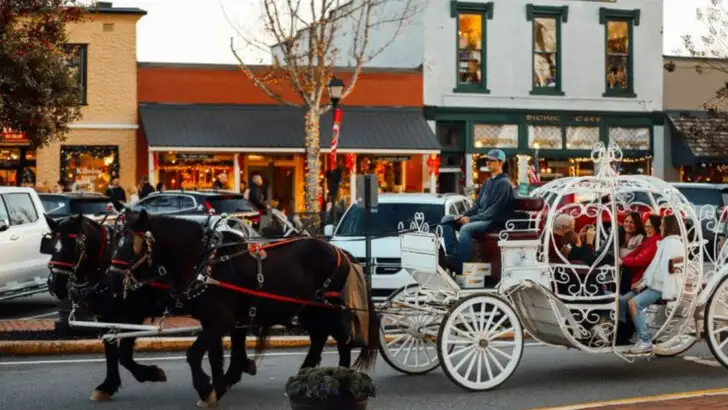I didn’t mean to fall for Dahlonega. But here we are. One weekend visit turned into two. Then three. Now I’m plotting excuses just to return. Because this quiet little mountain town in Georgia? It gets under your skin—in the best way. You’ll come for the gold rush history or maybe the nearby hiking trails. But you’ll stay for the porch swings, the local wine, and the way strangers say hello like you’ve lived there for years. It’s cozy without being boring. Charming without trying too hard. And once it grabs you, good luck staying away.
Sourwood Trees Glowing Red in Fall
In late October, sourwood trees light up the hillsides with deep red leaves. Their lacy branches bring elegance to woodland paths and backroads. The smooth gray bark adds texture, making them a photographer’s delight. Standing under their canopy, one feels a deep connection to nature’s seasonal dance. These trees not only beautify the landscape but also provide a unique rhythm to the town’s fall scenery. A fun fact: sourwood’s honey is a local favorite, celebrated for its distinct flavor. As leaves flutter down, they create a crimson carpet, inviting residents and visitors alike to pause and admire.
Black-Eyed Susans Brightening Road Edges
These cheerful yellow flowers bloom in sunny patches along town roads and trail openings. Each flower, with its stark dark center, stands as a beacon of summer’s warmth. From early summer to late fall, they transform ordinary paths into lively canvases of color. Gardeners cherish their resilience and long blooming season. In local folklore, they’re seen as symbols of justice. Walking or driving by, one can’t help but smile at their unyielding brightness. This resilience makes them a favorite among locals, turning grey days cheerful. Their sunny disposition ensures they’re always in demand.
Mountain Laurel Lining the Streams
Mountain laurel shrubs grow densely along creeks and shady paths in the nearby Chattahoochee National Forest. Their glossy green leaves are a year-round delight, but in late spring, they truly shine. Clusters of pink and white flowers bloom like small lanterns, illuminating the undergrowth. These shrubs have a storied history, often celebrated in Cherokee legends. Walking by, their subtle fragrance enchants hikers and nature lovers. They are a testament to nature’s artistry, offering both beauty and solace. Though delicate in appearance, they’re resilient, thriving in the forest’s shade. Their presence adds a gentle elegance.
Eastern Hemlocks Along Cool Ravines
Hemlock groves create a shaded, peaceful atmosphere near rivers and waterfalls outside town. Their fine needles whisper with the wind, offering a sense of tranquility to all who pass. Summer days feel cooler beneath their drooping branches. Once threatened by pests, efforts are underway to preserve these majestic trees. Their presence is crucial, providing habitat for various wildlife. Did you know? Hemlocks can live for over 500 years. Standing among them, one feels a serene connection to the earth. Their legacy is one of quiet strength and enduring beauty, making them a local treasure.
Wild Azaleas on the Slopes
In April and May, native azaleas bloom in oranges, pinks, and whites along forested ridges. Unlike their garden cousins, these azaleas thrive naturally in dappled light, offering a sweet scent that wafts through the air. Their blossoms are a herald of spring, turning slopes into a painter’s palette. Local legends speak of their mystical powers. Hikers and botanists alike admire their wild, untamed beauty. Each flower is a testament to the resilience and creativity of nature. Their seasonal dance is eagerly anticipated, marking the landscape with vibrant hues and a gentle fragrance.
Mushrooms on Woodland Trails
Fall rains bring a wide variety of mushrooms to the forest floor, especially near rotting logs. These fungi, each unique in shape and color, are nature’s hidden treasures. From pale puffballs to bright orange caps, they appear suddenly, adding a dash of mystery to woodland walks. Mushrooms play a vital role in the ecosystem, breaking down organic matter. Did you know? Some are edible delights, while others hold secrets best left untasted. Their ephemeral presence invites curiosity and caution. Foragers tread carefully, respecting their role in the forest’s intricate web of life.
Christmas Ferns Staying Green Year-Round
These ferns are one of the few that keep their deep green color through winter. Their arching fronds grow in clumps beneath hardwoods and along mossy rocks, offering a verdant contrast to the barren winter landscape. Known for their resilience, they symbolize hope and eternal life in various cultures. As other plants fade, their enduring green reassures all who wander the woods. Did you know? They get their name because they remain vibrant even during the festive season. Their presence is a reminder of nature’s persistence, thriving despite the cold’s embrace.
Goldenrod Lighting Up Meadows in Late Summer
Goldenrod fills the fields just outside town with tall, yellow flower spikes buzzing with bees. It’s often mistaken for ragweed but doesn’t trigger allergies—and plays a key role in late-season pollination.
Shortleaf Pines on Dry, Sunny Ridges
These pines thrive on drier slopes, where their open branches let sun filter through. Their needles grow in pairs and the bark peels in small, reddish plates—easy to spot for curious hikers.
River Cane Along Lowland Trails
River cane, a native type of bamboo, grows in dense thickets near streambeds. It rustles in the breeze and offers shelter for small birds and mammals in the quieter parts of the forest.

